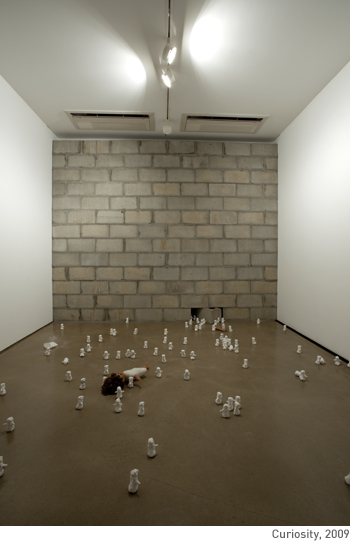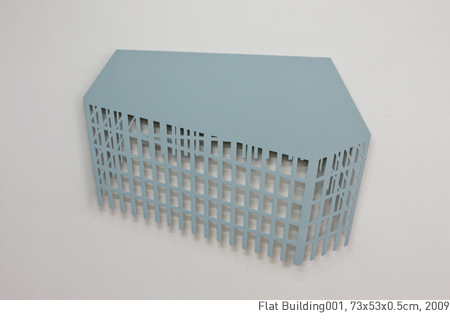

2006 heralds a new stage in Dong-Yeon Kim’s oeuvre. Dong-Yeon Kim’s circumstances foster his artistic development and demand that he realise his ideas on a grand scale. Within a brief period of time Kim makes numerous series of ceramic and aluminium objects, accompanied by drawings and paintings, systematically enlarging his artistic vocabulary and establishing new self-evident impulses.
Architecture and systems of pathways which have their historical roots in the 20’s are central to this new phase. The square, oblong or tower-shaped objects resemble buildings with lattice-like facades, models of metropolitan multi-storey high-rise architecture. They bear witness to the structural building designs regarded as modern, abstract and functional by the New Objectivity movement. This style also had its critics who regarded it as anonymous and standardized an ambiguity that is amplified in Kim’s works. The perfect geometry and sharply delineated contrasts of some of the constructions recall graphically reduced characters or perfectionist works of minimal art such as those by Donald Judd. However the grid constructions are not self-contained, geometric forms. They have neither foundations nor a base plate but appear to stand on stilts and look like upturned cages, baskets or fish traps. Some of them are rather bent and crooked, giving the futuristic architectural style an archaic touch. The grid-like architecture of the facades looks as if it is still under construction and appears fragile and instable. One could easily conclude that the buildings are already threatened with collapse before completion.
Also belonging to this body of works is a series in which Kim uses central perspective to make two-dimensional drawings of the grid-like architecture of the facades, enlarging them, cutting out the silhouettes and spacing them at intervals on the walls and floor. These works look like three-dimensional cuboids whereas in reality the supposed volumes are entirely flat and nearly as disembodied as shadows. The illusion of depth however is supplemented and compounded by the actual shadows. Kim draws the viewer into a complicated philosophical discourse on appearance and reality and on model-like sculpture and two-dimensional representations of space.
Another cyclic motif and one that has captivated Kim right from the very start of his artistic production is concerned with the routeing
andconfigurationofstreetsandroads. In 2009 he turns to designs for motorway junctions derived from the so-called cloverleaf loop solutions favoured in the 20’s. Straight motorways intersect on various levels connected by ring-like right hand bends. De-contextualized the motorway junctions look like zestful, elegant emblems resulting from the harmonious interconnection of straight and curved lines. Kim mutates the original functional construction for a sophisticated traffic control system, designed to facilitate the ordered flow of traffic despite the high volume of cars on the road, into an allegory of steady energy channels. Here too the artist generates a “counter image”by cutting up the circles and crosses only to guide them through the room above the heads of the observers as a garland of thin paper snippets. As opposed to his earlier hanging cities, the suspended streets have abandoned any regulative system in favour of a chaotic structure. The traffic system has become a rampant, delicate, floral ornament, like a climbing plant composed of letter fragments.

A surprising development in Dong-Yeon Kim’s oeuvre isthe modelled figures, the so-called monsters that also make their debut in 2006. They are baggy, chunky creatures, which look as though they have been roughly fashioned out of plasticine. The figure consists of three spherical elements suggesting a head and upper and lower body, much like a snowman. The eyes are two small balls and the arms two flipper-like protrusions. As a result the monster appears awkward and sympathetic.
Like in the fable of Gulliver’s Travels the figure appears at times to be enormous and at others miniscule. The band of tiny figures performs human activities such as building and constructing, observing and looking. As spectators they animate the tiers of an imaginary arena and participate in a theatrical performance, or assume the roles of diligent builders of a three dimensional, geometric space on which they clamber about, apparently defying the laws of gravity.
The 89- 90cm high ceramic “big monsters” are variously black, white or a pastel shade of green, a colour commonly found in traditional Asian ceramics. The colour range symbolizes all of humanity. The “big monsters” roam through the exhibition space like ghosts from another world or observe the travails of their tiny counterparts with interest. This is not Kim’s first examination of the human figure. Previously he made cloud-shaped creatures, reminiscent of a Venus-like female form that emerge from narrow chimneys as voluptuous clouds of smoke. The monsters by contrast might have been made by a child from plasticine. The naïve workmanship and the monster’s chubby appearance negate any threat they might otherwise convey. These make-believe figures demonstrate how child-like creativity can unceremoniously transform spooky ghosts into benign spirits and irrational fears into positive energy.
Finally Dong-Yeon Kim turns to his perennial artistic fascination with mountains, rivers and lakes. His analytical grasp of such motifs, which in art historical terms are amongst the oldest that exist, has lead Kim to make objects in which external appearance and understanding, an exploration of surfaces and of depths, merge into one. Dong-Yeon Kim understands something that, to the normal human eye, looks like a flat disc or strip as a voluminous body. By combining vision and knowledge he turns a lake into an upside-down cone with a visible seam to indicate a mental construction. Enthroned on two upturned lakes that form twin peaks are the two central figures of ancient philosophy, Aristotle and Plato. The figures have been taken from Raphael’s “School of Athens”, presumably the most famous and frequently cited example of philosophical art. The painting represents the profound esteem in which the Renaissance held the philosophical teachings of ancient Greece. For Kim both thinkers emblematize the philosophical recognition of the existence of a notional “ideal” being alongside purely physical existence. He combines both states in his art, which therein finds it validation.
Despite its variety, Kim’s distinctive view of the world is the central theme running through his entire oeuvre.
By Dr. Annette Lagler / Ludwig Forum für International Kunst, Aachen